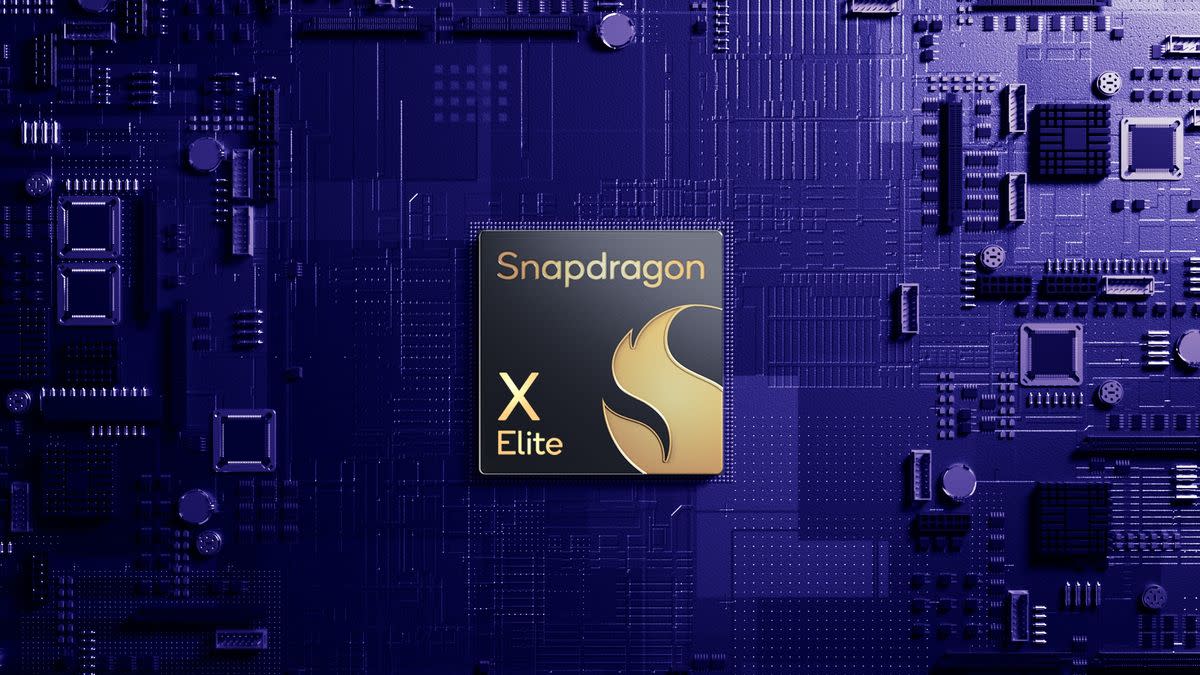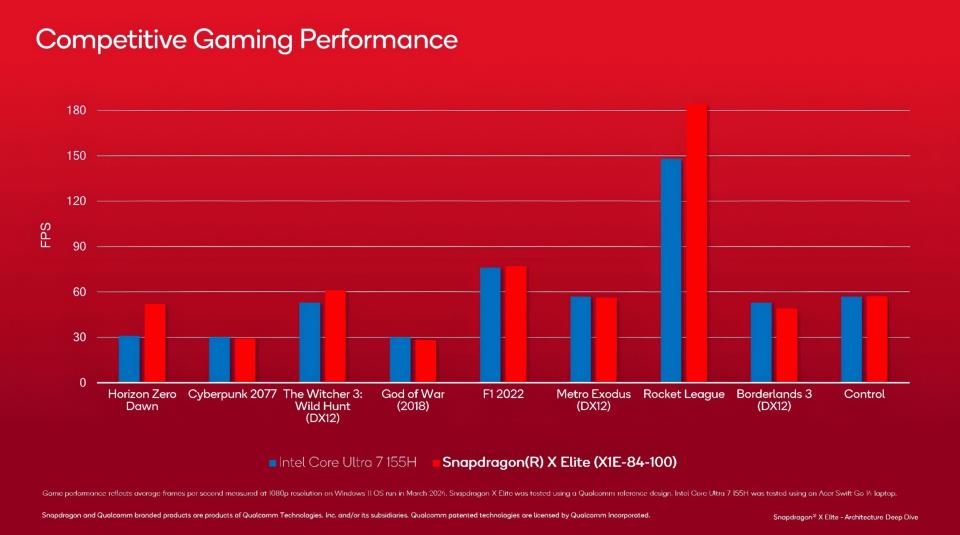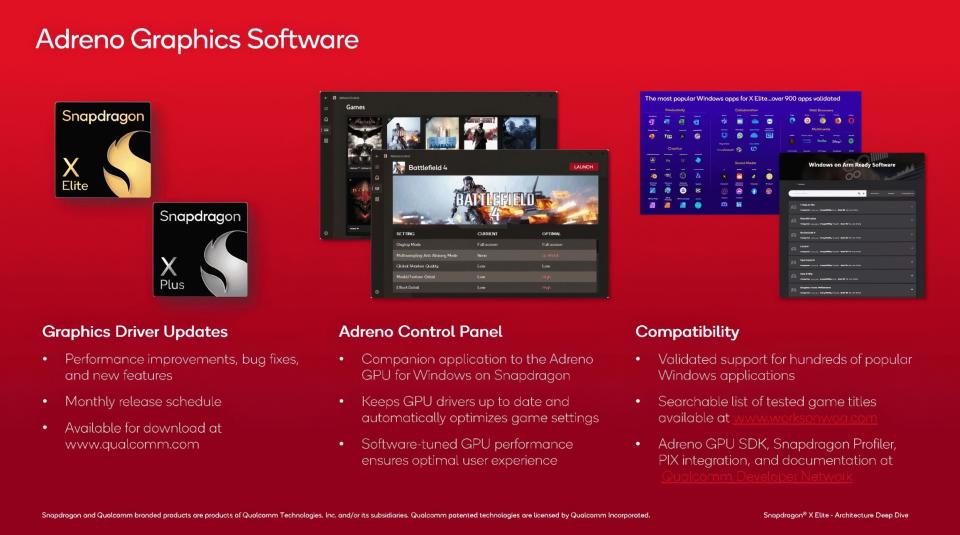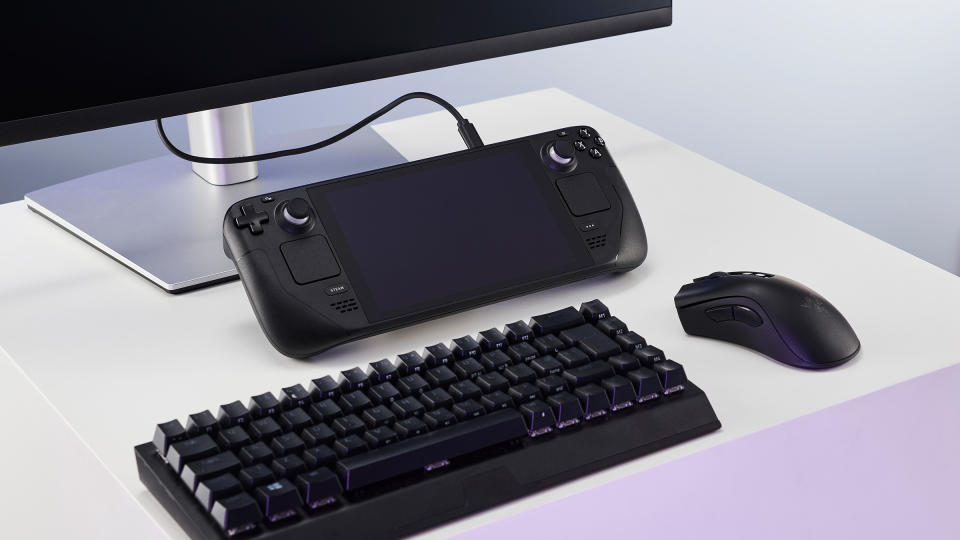Qualcomm touts Intel-beating gaming performance for its Snapdragon X Arm chip, promises gaming app plus monthly GPU driver updates

With the first examples of laptops powered by Qualcomm's new Snapdragon X chip landing with actual buying customers, Qualcomm has released some more juicy details around gaming performance and features. According to Qualcomm, its new Arm chip trades blows with Intel's Meteor Lake laptop CPUs, sometimes beating them handily, in a range of games.
The caveat, obviously, is that Qualcomm is hardly an unbiased source. But hold that thought. Qualcomm's latest marketing dump (via Anandtech) commits the company to monthly driver releases for the Snap X's Adreno integrated GPU. Qualcomm also has an Nvidia GeForce Experience-style app for the chip which includes pre-baked optimisations and settings for a range of Windows game titles. So, yeah, Qualcomm is pushing pretty hard with the whole gaming thing.
The new performance numbers show the chip trading blows with Intel's Core Ultra 155H in a suite of nine games running at 1080p. At worst, Qualcomm's benchmarks have the Snapdragon X's Adreno GPU just behind the Intel chip. But in several games, the Qualcomm Arm processor is some distance ahead.
Inevitably, these benchmarks raise as many questions as they answer. No details are given regarding settings other than the 1080p resolution, for example. It's not even clear if this is when running natively or with emulation for the CPU side of the equation, but we assume the latter.
Along with the promise of driver releases for the GPU on a monthly basis with performance upgrades and bug fixes, there's the Adreno Control Panel companion app, which will keep drivers updated and automatically optimise settings on a per-game basis. It's all rather redolent of the sort of setups that Nvidia and AMD have for their gaming GPUs.

Arguably, these are the kinds of features and details that any company hoping to compete in gaming graphics on the PC now needs, but it is perhaps something of a surprise to find Qualcomm pushing so hard on gaming. It's such a big ask to move into gaming with not only what is a new GPU architecture in the context of serious PC gaming (it's actually not a new GPU architecture at all in the Android phone space), let alone doing it on the back of an Arm rather than x86-based CPU.
Speaking of the Adreno GPU in the Snapdragon X, you can trace its origins back to Qualcomm's acquisition of a slew of "handheld graphics and multimedia assets" including mobile graphics from none other than AMD. Indeed, Adreno is intentionally an anagram of Radeon. Truly, there is nothing new under the sun.
Anyway, Qualcomm has historically been very cagey about the details inside its Adreno GPUs. But with the shift to a PC focus with the Snapdragon X, arguably there's a need for more openness if the gaming and development community is going to support the new platform. Happily, Qualcomm seems to recognise that and has lifted the lid somewhat on Adeno's inner workings.

It's not worth going over the details in forensic detail. But the highlights go something like this. Adreno X1, as the version of Adreno in the Snapdragon X is known, isn't an absolutely cutting-edge architecture.
It's limited to the DX12.1 rather than the latest DX12.2 feature set, also known as DirectX 12 Ultimate. That's reflected in partial rather than full hardware ray tracing support (there's no hardware BVH traversal, for instance), while other DX12.2 features like mesh shaders also aren't supported.
More on the Steam Deck

Steam Deck OLED review: Our verdict on Valve's handheld.
Best Steam Deck accessories: Get decked out.
Steam Deck battery life: What's the real battery life?
Best handheld gaming PC: What's the best travel buddy?
The GPU does, however, have features akin to Nvidia's Tensor cores, which begs the question of whether Qualcomm might have something akin to Nvidia's deep-learning enhanced upscaling technology, DLSS, in the works.
Again, arguably Qualcomm will need features like that if it is to compete with the likes of Nvidia in PC graphics. It's an awfully tall order, as Intel has found with its Arc graphics.
That note of caution aside, it sure feels exciting to be in PC gaming right now. This time next year, who knows what marvels will be available. Could the Snapdragon X be a good budget gaming option or a great chip for handhelds? Maybe Intel's Lunar Lake will be killer? Or should that be AMD's Strix Point?
Then there are whole new GPU architectures from Nvidia, AMD and Intel expected, all within the next six months or so. It's a good time to be into PC gaming, that's for sure.


